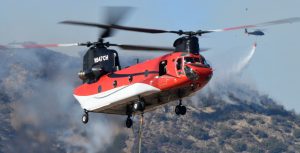
By Steve Gorman
LOS ANGELES (Reuters) – Thousands of weary firefighters, battling a deadly 2-week-old California wildfire that ranks as the third largest in state history, welcomed a second straight day of favorable weather on Monday that allowed a more aggressive attack on the flames.
The so-called Thomas fire has scorched 271,000 acres (110,000 hectares) of drought-parched chaparral and brush in the coastal mountains, foothills and canyons of Ventura and Santa Barbara counties northwest of Los Angeles.
The burned zone encompasses an area about a third of the size of the state of Rhode Island.
More than 1,000 homes and other buildings have gone up in flames and some 18,000 other structures remained threatened from a late-season firestorm that kept firefighters on the defensive for the better part of two weeks.
One firefighter lost his life, succumbing to smoke inhalation and burns last Thursday near the town of Fillmore in Ventura County.
A mix of lighter winds, rising humidity and cooler air temperatures prevailed for a second day on Monday, affording crews the greatest weather break they had seen yet, said Lynne Tolmachoff, a spokeswoman for the California Department of Forestry and Fire Protection (CalFire).
“Everybody is breathing a sigh of relief that this will give those firefighters a chance to get in there and do some good work, and not just be constantly chasing things,” she told Reuters by telephone.
A firefighting force of 8,500 personnel had carved containment lines around 50 percent of the blaze’s perimeter as of Monday night, up from 45 percent earlier.
But coastal communities within the towns of Santa Barbara, Montecito and Summerland were still at risk as crews hurried to extend and shore up buffer zones before a return of higher winds forecast for Wednesday, Tolmachoff said. Full containment is not expected before the second week of January.
The blaze erupted on Dec. 4 and was stoked by hot, dry Santa Ana winds blowing with rare hurricane force from the high desert to the east, spreading the flames across miles of rugged coastal terrain faster than firefighters could keep up.
The latest tally of burned landscape puts the Thomas blaze among the three largest wildfires documented in California, approaching the record size of the 2003 Cedar fire in San Diego County that consumed 273,246 acres (110,600 hectares) and killed 15 people.
The Thomas fire has displaced more than 100,000 people, although authorities in Santa Barbara County lifted evacuation orders for additional areas no longer considered to be in harm’s way, and more communities were to be reopened on Tuesday.
CalFire has put the estimated cost of fighting the blaze at nearly $131 million. The cause remained under investigation.
The Thomas came two months after a spate of wind-driven blazes in Northern California’s wine country incinerated several thousand homes and killed more than 40 people, ranking as the deadliest rash of wildfires, and one of the most destructive, in state history.
(Additional reporrting by Chris Kenning in Chicago and Peter Szekely in New York; Editing by Clive McKeef and Peter Cooney)










